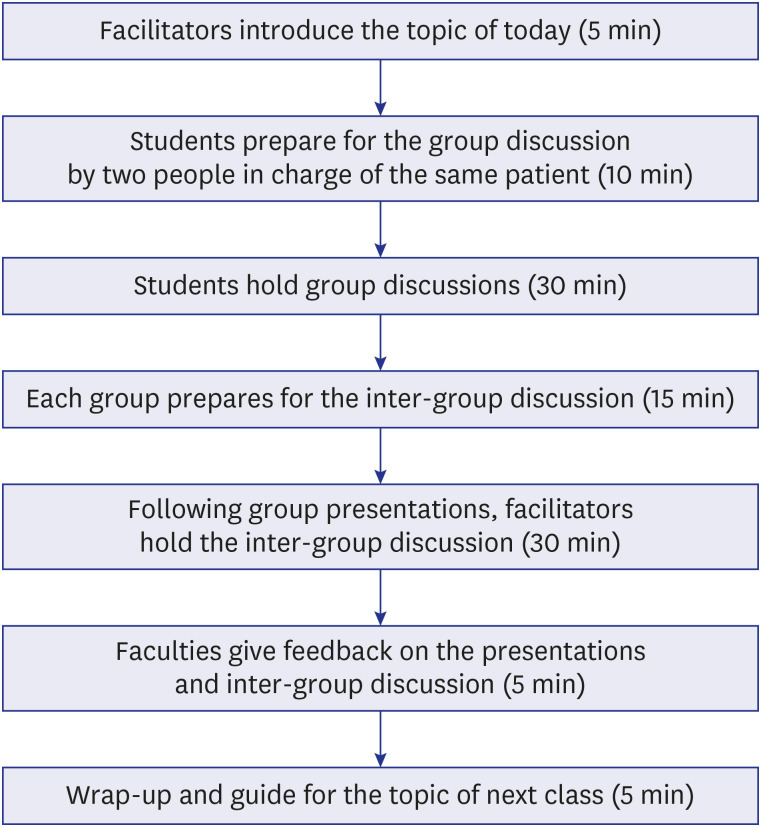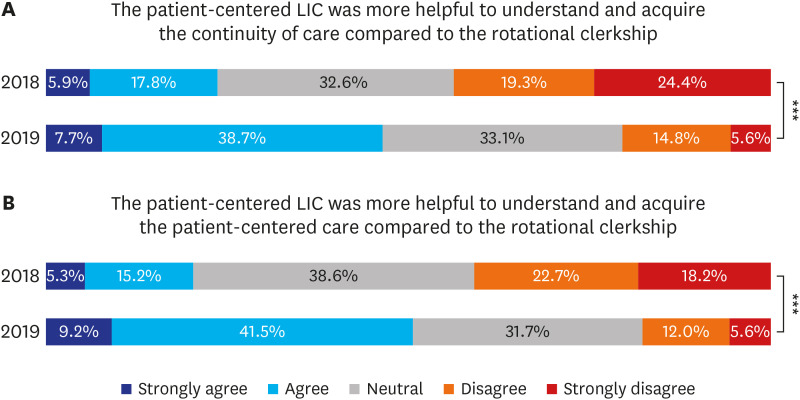J Korean Med Sci.
2020 Dec;35(50):e419. 10.3346/jkms.2020.35.e419.
Establishing a Patient-centered Longitudinal Integrated Clerkship: Early Results from a Single Institution
- Affiliations
-
- 1Office of Medical Education, Seoul National University College of Medicine, Seoul, Korea
- 2Department of Internal Medicine, Seoul National University College of Medicine, Seoul, Korea
- KMID: 2509753
- DOI: http://doi.org/10.3346/jkms.2020.35.e419
Abstract
- Background
Longitudinal integrated clerkships (LICs) have been adopted by medical schools to overcome the limitations of traditional block clerkship rotations and to promote continuity of care. In 2018, Seoul National University College of Medicine introduced a patient-centered LIC program as part of a new curriculum in parallel with traditional block rotation clerkships. The purpose of this study was to present the patient-centered LIC program and to investigate its educational effects.
Methods
In 2018 and 2019, a total of 298 third-year medical students participated in the LIC program. We divided the students into groups of eight, which were organized into corresponding discussion classes. Throughout the academic year, students followed up patients by interviewing them at the hospital or reviewing their electric medical records. Discussion classes on set topics were held seven times per year with facilitators and clinical faculties. Students completed a course evaluation questionnaire at the end of the academic year. The questionnaire included 22 items measured on a 5-point scale and two open-ended questions asking about the benefits and limitations of the program. The items covered three domains: student experience, satisfaction, and self-assessment. Final reflective essays were collected as both student assessments and data for qualitative analysis.
Results
During the study period, the overall experience of the students improved. We increased the number of faculty members and patients and decreased the number of students in each discussion class. We also provided additional feedback through an e-portfolio. Students' satisfaction changed positively. Compared to the rotational clerkship, students answered that the LIC provided additional help in learning the two core competencies. During the first 2 years of the program, the percentage of students who answered that the program was more helpful than the rotational clerkship increased from 23.7% to 46.4% for continuity of care (P < 0.001), and from 20.5% to 50.7% for patient-centered care (P < 0.001).
Conclusion
Our patient-centered LIC, in parallel with traditional block rotation clerkships, had a positive effect on students' experience of continuity of care and patient-centered care.
Keyword
Figure
Reference
-
1. Hirsh DA, Ogur B, Thibault GE, Cox M. “Continuity” as an organizing principle for clinical education reform. N Engl J Med. 2007; 356(8):858–866. PMID: 17314348.
Article2. Hong JS, Kang HC, Kim J. Continuity of care for elderly patients with diabetes mellitus, hypertension, asthma, and chronic obstructive pulmonary disease in Korea. J Korean Med Sci. 2010; 25(9):1259–1271. PMID: 20808667.
Article3. World Health Organization. People-centered health care: technical papers: international symposium on people-centered health care: reorienting health systems in the 21st century, the Tokyo International Forum, 25 November 2007. Manila: WHO Regional Office for the Western Pacific;2008.4. Epstein RM, Fiscella K, Lesser CS, Stange KC. Why the nation needs a policy push on patient-centered health care. Health Aff (Millwood). 2010; 29(8):1489–1495. PMID: 20679652.
Article5. Merlino JI, Kestranek C, Bokar D, Sun Z, Nissen SE, Longworth DL. HCAHPS survey results: impact of severity of illness on hospitals' performance on HCAHPS survey results. J Patient Exp. 2014; 1(2):16–21. PMID: 28725804.
Article6. Hwang SM, Lee JJ, Jang JS, Gim GH, Kim MC, Lim SY. Patient preference and satisfaction with their involvement in the selection of an anesthetic method for surgery. J Korean Med Sci. 2014; 29(2):287–291. PMID: 24550660.
Article7. Health Insurance Review and Assessment Service. Comprehensive report on quality assessment of NHI 2016. Updated 2018. Accessed August 7, 2020. https://www.hira.or.kr/bbsDummy.do?pgmid=HIRAJ030000001000&brdScnBltNo=4&brdBltNo=46914.8. Cooke M, Irby DM, Sullivan W, Ludmerer KM. American medical education 100 years after the Flexner report. N Engl J Med. 2006; 355(13):1339–1344. PMID: 17005951.
Article9. Im SJ. Strategies for effective teaching in clinical clerkship. Hanyang Med Rev. 2012; 32(1):51–58.
Article10. Yang E, Suh DJ, Lee Y, Lee S, Kim S, Lee E, et al. Status of clerkship education and its evaluation in Korean medical schools. Korean J Med Educ. 2007; 19(2):111–121.
Article11. Worley P, Couper I, Strasser R, Graves L, Cummings BA, Woodman R, et al. A typology of longitudinal integrated clerkships. Med Educ. 2016; 50(9):922–932. PMID: 27562892.
Article12. Association of American Medical Colleges. Curriculum reports: longitudinal integrated clerkships at US medical schools. Updated 2020. Accessed July 28, 2020. https://www.aamc.org/data-reports/curriculum-reports/interactive-data/longitudinal-integrated-clerkships-us-medical-schools.13. Yoon HB, Moon SH, Myung SJ, Park JB, Park WB. Pilot study results of a longitudinal integrated clerkship in a single institution. Korean Med Educ Rev. 2018; 20(1):15–19.14. Bleasel J, Burgess A, Weeks R, Haq I. Feedback using an ePortfolio for medicine long cases: quality not quantity. BMC Med Educ. 2016; 16(1):278. PMID: 27769240.
Article15. Alliance for Clinical Education, Poncelet A, Hirsh D. Longitudinal Integrated Clerkships: Principles, Outcomes, Practical Tools, and Future Directions. North Syracuse, NY: Gegensatz Press;2016.16. Osman N, Atalay A, Ghosh A, Saravanan Y, Shagrin B, Singh T, et al. Structuring medical education for workforce transformation: continuity, symbiosis and longitudinal integrated clerkships. Educ Sci. 2017; 7(2):58.
Article
- Full Text Links
- Actions
-
Cited
- CITED
-
- Close
- Share
- Similar articles
-
- Pilot Study Results of a Longitudinal Integrated Clerkship in a Single Institution
- Development and Operation of Longitudinal Integrated Clerkship Programs in Overseas Medical Schools
- Erratum: Correction of Text and Table in the Article "Establishing a Patientcentered Longitudinal Integrated Clerkship: Early Results from a Single Institution"
- The Concept and Background for Introducing Longitudinal Integrated Clerkships
- How to enhance students’ learning in a patient-centered longitudinal integrated clerkship: factors associated with students’ learning experiences



